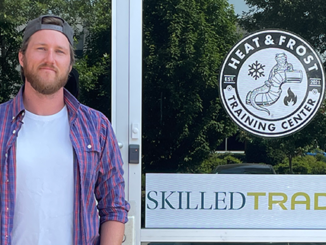
AltaML offers straightforward, non-pretentious AI solutions for contracting businesses.
By / Jessica Kirby
Back-flipping robots, self-driving hover cars, breakfast food that prepares itself—this is all the stuff television AI is made of… But is this what it would mean for your business?
Cory Janssen is co-founder and co-CEO of AltaML, one of North America’s largest venture studios focused on artificial intelligence and machine learning, and he says, “No way.”

“Frankly, the best approach is to forget what you think you know about AI and think about it like using your data to improve your business processes,” he says. “Our focus is taking existing technology and applying it to business problems to get a true business result.”
(Fun fact: Cory was co-founder of Investopedia, a financial education site that has become one of the most popular financial sites on the Internet. It was sold to Forbes Media in 2007.)
AltaML thinks of itself as a blue collar AI company, which means it offers a straightforward, non-pretentious way forward that will help you get rid of the parts of your job that you hate.
“We don’t sit in an ivory tower and try to talk about things people don’t understand,” Janssen says. “The theme here is building tools to help professionals make better business decisions.”
AltaML applies machine learning (ML) and generative AI (genAI) to specific elements of a business, which essentially introduces a new set of tools. But first, it is helpful to understand what these words mean.
In simple terms, ML is computer software that can adapt without being specifically programmed. All the buzz is about genAI, which is a new category of AI that builds on that foundation by creating content (such as text, video, or computer code) and adds new capabilities that attempt to mimic human intelligence, creativity, and autonomy.
“A CNC machine, for example, has programming that tells it how to build things,” Janssen says. “We know the rules, and we just program it to understand, ‘if this, then that’.
“Machine learning says we don’t know the rules but we have examples from the past, so we ask the software, ‘Can you find out what the commonalities are based on past data and predict what the rules should be?’”
Imagine you’re a bank, for instance, and you want to grant mortgages. To mitigate risks, you’re going to want to try to predict which of those may default.
“If you go back and see you have 1,000 defaulted mortgages, you can use ML software to look at those applications and see what patterns exist in the ones that didn’t go well and that maybe a human didn’t see because it requires charting 100 variables,” Janssen says.
And speaking of humans, don’t be too quick to assume AI will be replacing our workforce—although using it will enhance it.
“Experts are very good, and technology—even if it is good technology—will still need a human in a ton of areas where it comes to regulation,” Janssen says. “We won’t replace radiologists with AI, for example, but radiologists who use AI will replace those who don’t. It isn’t because the technology isn’t there, but who is going to sign off on the liability that a radiologist takes on?
“It’s like going from a screw driver to a power drill.”
One key addition to the new set of tools is the concept of copilots, which streamline administrative tasks so human beings can focus on the elements of work that inspire them.
Copilot from Microsoft, for example, summarizes long email threads and quickly drafts suggested replies, helping you clear your inbox in minutes, not hours. Copilot in Teams makes meetings more productive by summarizing key discussion points—including who said what and where people are aligned and where they disagree—and suggesting action items—all in real time during a meeting.
“Software engineers using copilots have reported a 20-30% increase in performance,” Janssen says. “We believe there will eventually be a copilot with deep industry knowledge in virtually every segment of the economy.”
To illustrate this, he points to giving an apprentice working on a jobsite the ability to access building codes by asking questions to his or her cellphone.
“On top of that, construction is one of many industries with people in their 50s and 60s retiring,” Janssen adds. “How can you make sure you retain that knowledge?”
When he addresses the TIAC membership, Janssen will cover some background and terminology and then share the critical factors of success in applying ML/genAI in the industry. Using real-life examples from adjacent industries, he will present simple, effective ways mechanical insulators can improve their business processes.
“We will look at whether you have the scale to implement these technologies, whether you should be doing this on your own or with a company’s software, and whether collecting the right data now could help you make better decisions in the future,” Janssen says.
He will also touch on responsible AI, which is a next-level look at identifying biases in the data and how those may exacerbate problems.
“Do you think there has been bias in society over the past 50 years? Of course,” he says. “Once you understand that, you can be aware of it so it doesn’t negatively affect your predictions.”
Expect tangible takeaways, useful business tools, and streamlined business processes for the future—but don’t count on backflipping robots. “You see a lot of drama around AI on TV,” Janssen says. “What we are talking about is less sexy, but once the AI hype subsides, we will have a huge advantage over those who don’t understand or use it.”
Cory will provide a Machine Learning 101 session to educate delegates on the fundamentals. He will venture into the domain of Generative AI, explain what sets it apart from other facets of AI, and uncover the reasons behind its current buzz. Cory will also provide valuable insights on implementing AI into business and share current applications in the manufacturing and industrials sector.
Register for the conference at tiac.ca/en/annual-conference/2024-stjohns ▪



